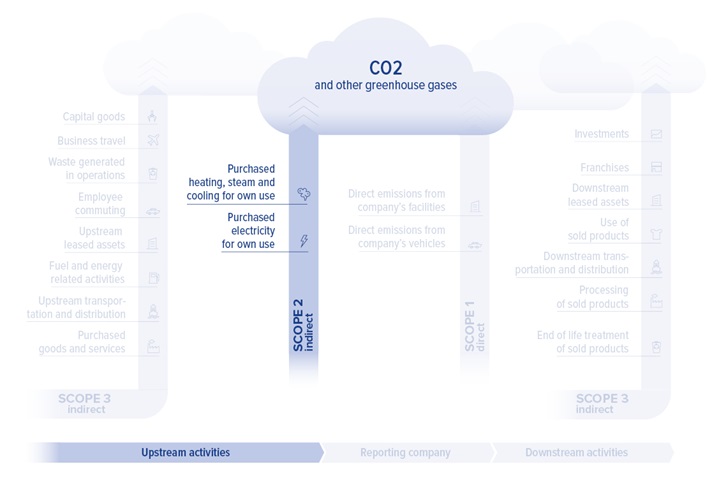Scope 2 emissions
Scope 2 emissions definition
One of the most significant global sources of GHG emissions is scope 2, which refers to indirect emissions from electricity or district heating purchased and used by a company. The GHGs are emitted during the production of the energy, not its use, and so are not directly caused by the company in question.
The Greenhouse Gas Protocol defines the three scopes of greenhouse gas (GHG) emissions that should be considered when calculating a corporate carbon footprint. This framework helps to establish which emissions should be attributed to a particular company and ensures that emissions are only counted once within each scope. In addition to the indirect emissions counted under scope 2, scope 1 covers the emissions from a company’s own or directly controlled operations, while scope 3 looks at the upstream and downstream emissions along the whole supply chain.
As scope 2 emissions physically occur at the facility where electricity is generated, they would fall into the scope 1 category for the power generator. This means that for an energy company, the same emissions are reported under scope 1.

Scope 2 emissions cover purchased heating, cooling, and electricity
Scope 2 emissions examples
Scope 2 emissions include indirect GHG emissions from purchased or acquired energy, like electricity, steam, heat, or cooling. To be counted under scope 2, the energy must be generated off-site and consumed by the reporting company.
A key example is electricity purchased from a utility company. The emissions occur when the energy supplier burns fossil fuels and converts the energy into electricity or heat. The emissions are generated offsite, so are therefore considered indirect emissions.
However, if a reporting company such as an industrial facility generates its own energy on-site from sources that it owns or controls, the associated GHG emissions will fall under scope 1. Similarly, companies like electricity suppliers that possess their own energy generation facilities and sell all their power into the local grid are directly causing the emissions and therefore count them under scope 1.
Scope 2 encompasses indirect emissions from only the generation of purchased or acquired energy. However, other emissions associated with the production and processing of fuels and the distribution of energy within a grid are tracked in scope 3.
How to reduce scope 2 emissions
Scope 2 emissions account for at least a third of GHG emissions, making them the largest source of global emissions. This is why assessing and measuring Scope 2 emissions present a significant emissions reduction opportunity.
As scope 2 emissions derive from operational energy usage, reducing these emissions comes down to company-wide energy-saving measures. The first step is always to calculate your corporate carbon footprint, to establish a baseline upon which reduction targets can be set.
Visit the ClimatePartner Academy to learn more about climate action.
